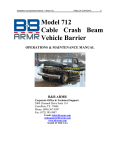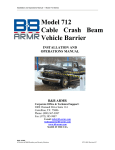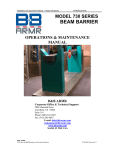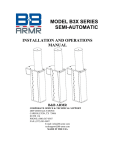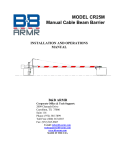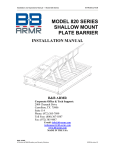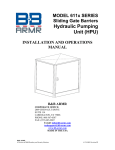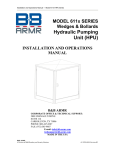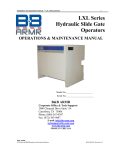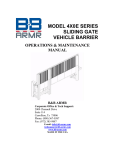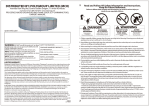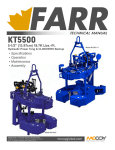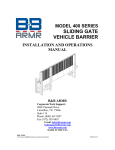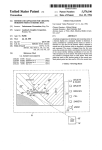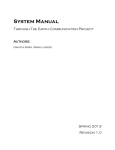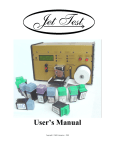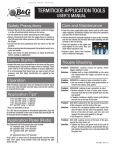Download Model 712 Cable Crash Beam Vehicle Barrier
Transcript
Installation and Operations Manual — Model 712 Series Model 712 Cable Crash Beam Vehicle Barrier INSTALLATION MANUAL B&B ARMR Corporate Office & Technical Support: 2009 Chenault Drive Suite 114 Carrollton, TX 75006 Phone: (800) 367-0387 Fax: (972) 385-9887 E-mail: [email protected] [email protected] www.bb-armr.com MADE IN THE USA B&B ARMR A Division of B&B Roadway and Security Solutions 0712-9001 Revision K7 Installation and Operations Manual — Model 712 INTRODUCTION INTRODUCTION Welcome! Congratulations on your purchase of a B&B ARMR vehicle barrier. In addition to providing detailed operating instructions, this manual describes how to install, maintain, and troubleshoot your vehicle barrier. If you require additional assistance with any aspect of your vehicle barrier's installation or operation, please contact us. With years of experience in all aspects of perimeter security and related disciplines, our products are used throughout the world to control access and to protect people, equipment, and facilities. We offer a broad range of vehicle barrier and related security services: Turnkey installations Routine barrier preventative maintenance or emergency repairs (including work on non-B&B ARMR products) Spare or replacement parts Custom designs or special installations Equipment upgrades (modernize your old equipment with state-of-the-art hydraulics and control systems) Ancillary security equipment such as security guard enclosures, card readers, security lighting, and many other security related products. Technical support via telephone and possible on site support with advanced scheduling. Safety SYMBOL MEANING: The lightning flash with arrowhead symbol, within an equilateral triangle, is intended to alert the user to the presence of non-insulated "dangerous voltage" within the product's enclosure that may be of sufficient magnitude to constitute a risk of electric shock to persons. B&B ARMR A Division of B&B Roadway and Security Solutions 0712-9001 Revision K7 ii Installation and Operations Manual — Model 712 INTRODUCTION iii The exclamation point within an equilateral triangle is intended to alert the user to the presence of important operating and maintenance (servicing) instruction in the literature accompanying the product. B&B ARMR does not assume responsibility for injury to persons or property during installation, operation, or maintenance. As the user, you are responsible for correct and safe installation, operation, and maintenance of this equipment. Users must follow the specific instructions and safety precautions located in this manual. In addition they must: Follow the safety standards of the Occupational Safety and Health Administration (OSHA), as well as other applicable federal, state, and local safety regulations and industry standards and procedures. For installation outside the United States, users must also follow applicable international, regional, and local safety standards. Engage only trained and experienced staff to install, operate, and maintain the equipment. Ensure that all repairs are performed correctly, using properly trained technicians and the correct tools and equipment. Additional safety devices may be included with this barrier system: o Vehicle loop detector(s) – Safety loop o Traffic arms o Traffic lights Warranty B&B ARMR vehicle barriers are guaranteed against defects in materials and workmanship for one year. The warranty applies when the barrier is installed, operated, and maintained according to the instructions in this manual, and when it is operated within the service conditions for which it was specifically sold. The user must prevent potentially damaging conditions, such as mechanical overloading or unauthorized modifications. In the event of a malfunction during the warranty period, contact B&B ARMR and we will pursue prompt corrective action. This is a warranty summary only. The specific warranty supplied with your equipment is the governing document. B&B ARMR A Division of B&B Roadway and Security Solutions 0712-9001 Revision K7 Installation and Operations Manual — Model 712 INTRODUCTION How to Contact Us If you have any questions or experience any problems with your vehicle barrier, or if we can help you with any other facility security issues, please contact us: Corporate/Tech Support: B&B ARMR 2009 Chenault Drive Suite 114 Carrollton, TX 75006 USA Telephone: (972) 385-7899 Toll Free: (800) 367-0387 Fax: (972) 385-9887 E-mail: [email protected] [email protected] System Installation Record To assist in documenting the products installed in your system, please take a minute to record the following reference information. This information can be located on the blue B&B ARMR model number plate located on the product in the cylinder access area. Additional columns are added for your convenience in documenting other components in the system. Site: Job #: Date: Serial Number: Model Number: Voltage: Phase: B&B ARMR A Division of B&B Roadway and Security Solutions 0712-9001 Revision K7 iv Installation and Operations Manual — Model 712 TABLE OF CONTENTS Table of Contents INTRODUCTION........................................................................................................ii 1. 2. ORIENTATION ................................................................................................... 5 1.1 Overview .......................................................................................................................................... 5 1.2 Options ............................................................................................................................................. 7 1.3 Specifications ................................................................................................................................... 7 INSTALLATION .................................................................................................. 7 2.1 Introduction ...................................................................................................................................... 7 2.2 Preliminary Considerations ............................................................................................................. 8 2.3 Installing the Hinge and Receiver Posts .......................................................................................... 8 2.4 Installing the Conduit ....................................................................................................................... 8 2.5 Emplacement .................................................................................................................................... 9 2.6 Hydraulic Unit Installation .............................................................................................................. 9 2.7 Control System Installation .............................................................................................................10 2.8 Final Installation Steps ...................................................................................................................10 3. TROUBLESHOOTING ..................................................................................... 12 4. ENGINEERING DRAWINGS........................................................................... 14 4.1 Suggested Conduit Layout...............................................................................................................14 4.2 Clear Opening View ........................................................................................................................15 B&B ARMR A Division of B&B Roadway and Security Solutions 0712-9001 Revision K7 iii Installation and Operations Manual — Model 712 TABLE OF CONTENTS ...................................................................................................................................... 17 B&B ARMR A Division of B&B Roadway and Security Solutions 0712-9001 Revision K7 iv Installation and Operations Manual — Model 712 ORIENTATION 1. ORIENTATION 1.1 Overview The formal name for this vehicle barrier—illustrated on the cover of this manual—is the B&B ARMR Model 712 Cable Crash Beam. It is a beam-type barrier hinged at one side so that the beam can be raised and lowered to restrict and control vehicle access. The beam is reinforced with an interior steel cable, which significantly increases the barrier's vehicle stopping power (see specifications below). 1.1.1 Beam The beam is a rectangular aluminum extrusion. The beam retains its mill aluminum finish and is marked with red and white safety tape. The steel cable is contained inside the beam and anchored with two stainless steel rods at either end. These rods hold the cable during vehicle impact. The cable and its anchor rods substantially increase the barrier's stopping power compared to a beam barrier without these components. The impact energy is absorbed first by stretching the cable, and then the energy is transferred to the foundation through the hinge and receiver assemblies. 1.1.2 Posts The hinge and receiver posts are steel. The hinge post operates with internal bearings on a stainless steel axle that allows the beam to move in an arc of 85-87. The receiver post has a stanchion constructed of two steel weldments. The weldments direct and capture the beam when it is lowered, and securely contain the beam during a vehicle impact. The receiver post has a security latching pin that can be padlocked to prevent unauthorized operation when the barrier is unattended (see Figure 1-1 below). The barrier has a self-contained, exterior-mounted, automatic damping device. When the barrier operates at the design speed, this damper reduces any whipping action by the beam as it comes to the full, raised position. B&B ARMR A Division of B&B Roadway and Security Solutions 0712-9001 Revision K7 5 Installation and Operations Manual — Model 712 ORIENTATION Figure 1-1: Receiver Post Stanchion and Security Latching Pin Both the hinge post and receiver post are cast in place in a subterranean concrete pour. Both posts have elevation grade locators to aid the installation. The installation requires no above-grade concrete. The portions of the hinge and receiver posts that are imbedded are coated to prevent deterioration due to cement contact. The aboveground portions of the posts are primed and finish painted in black. 1.1.3 Hydraulic System & Controls The 712 barrier operates with a complete, self-contained hydraulic unit. It contains not only the hydraulic components, but also the electrical components and a programmable logic controller that is pre-programmed with the barrier's operating logic. The unit has a minimum 1.5 horsepower, 208 / 240-480 volt, three-phase motor. (A single-phase motor is available on special order.) An overload circuit protects the motor in the event of power fluctuations. The control unit is 120-volt, single-phase with 24-volt dc output. The motor powers a hydraulic pump that delivers oil through a series of valves as directed by the control unit. If the beam is in the up position for extended periods, the control circuit monitors any drift in the beam's position and automatically corrects the position. The unit includes a manual operation override so the beam can be raised and lowered during power outages. The hydraulic unit is in an aesthetically pleasing round enclosure with built-in environmental controls, including a heater and cooling fan. (An optional heating unit for B&B ARMR A Division of B&B Roadway and Security Solutions 0712-9001 Revision K7 6 Installation and Operations Manual — Model 712 ORIENTATION extreme winter conditions is available.) The unit has a built-in 120-volt convenience outlet (customer supplies power to outlet) and a master switch turns off all the power to the unit for maintenance and repairs. 1.2 Options The B&B ARMR Model 712 Cable Crash Beam is available with the following options. Consult your purchase order or other ordering documentation to determine whether your unit has the optional equipment. Manually operated hydraulic unit (these units are designated as Model 714) Single-phase hydraulic pump motor Hydraulic unit heater for extreme cold weather operation Various control panel options (touch screen panels, multiple panels, and so on) In-ground loop detector to detect the presence of a vehicle and prevent accidental lowering of the beam onto the vehicle Traffic lights (red and amber stop/go lights to signal the vehicle) Lights (LEDs) on the beam to increase the beam's visibility Receiver post heater Electromagnetic Lock 1.3 Specifications Key specifications for the B&B ARMR Model 712 Cable Crash Beam are as follows. Meets or exceeds US Navy Specification OR098-09-88 Certified vehicle-stopping power is 10,000 pounds at 18 mph. 2. INSTALLATION 2.1 Introduction The Model 712 is designed for quick and easy installation. However, every site is different and each Model 712 will vary due to the choice of options or special design features. Accordingly, the instructions below may have to be varied slightly for your particular installation. If you need help, or are unclear about any of these instructions, please contact B&B ARMR for assistance. Your safety is extremely important to us. Be sure to follow the specific instructions presented below. You are responsible for the correct and safe installation, operation, and maintenance of this equipment. B&B ARMR A Division of B&B Roadway and Security Solutions 0712-9001 Revision K7 7 Installation and Operations Manual — Model 712 ENGINEERING 2.2 Preliminary Considerations Before beginning site excavation and barrier installation, note the following important considerations. Inspect the site and verify there are no underground utilities or overhead wires or obstructions in the excavation area. If possible, locate the installation away from routine foot traffic to reduce the chance for pedestrian injury from the barrier's moving arm. If your site layout requires the hydraulic pumping unit be placed more than 4' from the barrier's hinge post, the hydraulic hose supplied will be too short. Contact B&B ARMR and we will help you determine the correct hose length. 2.3 Installing the Hinge and Receiver Posts Perform the following steps. 2.3.1 Excavate the hole for the hinge post as shown in the engineering drawing titled Model 712 Cable Crash Beam Suggested Conduit layout (see the Installation Drawings section at the end of this manual). Place supporting timbers over the excavation and parallel to the roadway. Place the hinge post in the excavation supported by these timbers, using the grade locators on the post to ensure the hinge post is set to the proper depth. There are 3/8" nuts welded to the grade locators (can be viewed in Detail A on same foundation drawing mentioned above). Insert all-thread in these nuts and through the supporting timbers and use the all-thread to adjust the hinge post so it is plumb and level. 2.3.2 Place string lines on either side of the hinge post and run the lines across the roadway to determine the receiver post location. Keep the string lines parallel and accurately measure the clear opening length. This length (see Model 712 Cable Crash Beam 12’ Clear Opening drawing for reference) is the distance between the inside (side facing the road) faces of the hinge post and the receiver post. Once the receiver post location is determined, excavate the receiver post's hole and position and plumb the receiver post as described above. 2.3.3 Verify the posts are positioned correctly by running a string line between the two. Pull the string from the center of the hinge post and perpendicular to the axle and verify it falls directly on the center of the receiver post, and the distance between the two is exactly the specified clear opening length for your barrier. 2.4 Installing the Conduit Perform the following steps, to install the conduit for the power, hydraulic lines, and control circuits, referring to the Submittal or drawing titled 712 Cable Crash Beam B&B ARMR A Division of B&B Roadway and Security Solutions 0712-9001 Revision K7 8 Installation and Operations Manual — Model 712 ENGINEERING Suggested Conduit layout (see the Installation Drawings section at the end of this manual). 2.4.1 The installation requires a minimum of three conduits. One 2" diameter PVC conduit for the hydraulic lines, one ¾" diameter PVC conduit for the power cables, and one ¾" diameter PVC conduit for the control cables. One 3" diameter PVC conduit for the hydraulic lines would be required if the runs exceed 25’. All conduits, fittings, sweeps, and couplings must be electrical grade (gray color); do not use plumbing type (white color). Additional conduits may be required for traffic lights, loop detectors, and other options. Contact B&B ARMR if you are unclear about the conduit requirements for your installation. 2.4.2 All conduits are run to the hydraulic pump unit, where they will enter the unit through a common 17" diameter opening. Accordingly, run all the conduits for your installation to the location where the hydraulic unit's concrete pad will be located. This pad is typically placed so that the centerline of the hydraulic unit is 4' from the back of the hinge post, though your installation may require that the pad be located a different distance from the hinge post. (Not closer than 3' unless the unit is off to one side.) Run the conduits together and be sure the conduits are long enough to extend above the anticipated height of the hydraulic unit's pad. 2.4.3 After installing the conduits, verify that the hinge and receiver posts have not moved by repeating step 2.3.3 above. 2.5 Emplacement 2.5.1 Fill the hinge post and receiver post excavations with concrete and finish the concrete surface. Remove any splattered concrete from the posts. Verify the posts did not move out of alignment during the pour by repeating step 2.3.3 above. Allow the concrete to cure. 2.5.2 Pour the pad for the hydraulic unit, and finish the concrete surface. Remove any concrete that might have splattered inside the exposed conduits. Allow the concrete to cure. 2.6 Hydraulic Unit Installation Refer to the Submittal or the HPU user manual. 2.6.1 Place the hydraulic unit on the pad over the exposed conduits and bolt the unit in place. (The feet on the unit will accept standard concrete anchors.) If you mount the unit to an intermediate steel structure, make sure that structure is securely fastened to the pad. 2.6.2 Terminate the electrical conduits in the electrical box and the hydraulic hose conduit onto the JIC fittings. The hydraulic conduit should not extend above B&B ARMR A Division of B&B Roadway and Security Solutions 0712-9001 Revision K7 9 Installation and Operations Manual — Model 712 ENGINEERING the height of the unit's internal ring. This will allow the hydraulic hose to move slightly when pressure is applied without rubbing against any sharp edges on the conduit. 2.6.3 Install the hose by pulling it into the conduit, making sure to protect the hose from any sharp edges. When you cut the hose to length do not cut it too short, as the hose will shrink slightly in length when under pressure. 2.6.4 Connect the “up” hose fitting to the bottom of the flow control valve and connect the “down” hose fitting to the left side of the pump at the tank breather. 2.6.5 After connecting the hose at the pump you must purge air from the cylinder and lines. Verify the motor power is OFF. Hand-crank the motor clockwise until oil comes out of the hose. Stop cranking and terminate the hose on the bottom fitting of the hydraulic cylinder. Terminate the breather line on the top fitting of the hydraulic cylinder. 2.7 Control System Installation For this section, refer to the HPU user manual that came with the unit for more details. + Install three-phase or single-phase power (as appropriate to your Model 712) to the upper left corner of the electrical box. For three-phase systems use the terminals marked L1, L2, L3, Neutral, and Ground. For single-phase 220-volt systems use the terminals marked L1, L2, Neutral, and Ground. And for single-phase 120-volt systems use the terminals marked L1, Neutral, and Ground. All devices that require AC power (such as the loop detector, radio remote, traffic light, and infrared beam) can get 120-volt AC from the upper left side of the electrical cubical. Most other wiring is low-voltage (24-volt dc). Terminate all low-voltage inputs on the orange terminal blocks at the top of the electrical box. Wire all switching devices (barrier up, barrier down, limit switch, and so on) so that each device gets 24-volt dc positive power from the red terminal blocks. Attach each device's input termination point wire to the appropriate terminal block as referenced in the HPU user’s manual 2.8 Final Installation Steps 2.8.1 Attach the beam to the hinge post using the stainless steel axle, sliding the axle through the flange-mounted bearing, through the bronze bushing on the beam, and into the second bearing. Use the setscrews on the bearings to lock the axle in place. In addition, there are shaft collars on either side of the beam. Tighten these collars on the sides of the beam not the stanchion posts, to lock the beam in place. B&B ARMR A Division of B&B Roadway and Security Solutions 0712-9001 Revision K7 10 Installation and Operations Manual — Model 712 ENGINEERING 2.8.2 Attach the hydraulic cylinder to the hinge post and the beam using the clevis pins provided. 2.8.3 If ordered, the 6120 HPU oil tank is shipped with the required amount of. (The tank holds 2 gallons.). If it becomes necessary to add hydraulic oil, add the oil through the oil vent assembly. (See the Maintenance section for oil specifications and additional details.) Figure 1.2 Drive Stanchion Assembly. B&B ARMR A Division of B&B Roadway and Security Solutions 0712-9001 Revision K7 11 Installation and Operations Manual — Model 712 ENGINEERING 12 3. TROUBLESHOOTING The table below provides guidance on identifying and correcting any problems with your B&B ARMR Model 712 Cable Crash Beam vehicle barrier. If you encounter problems that you cannot fix, contact B&B ARMR and we will gladly work with you to correct them. Model 712 Troubleshooting Guide Symptom Actions 1. Check power 2. Check overload protector Beam arm does not go up 3. Check PLC input 4. Check that safeties are clear 5. Check PLC output 6. Check push button operation 1. Check power 2. Check overload protector 3. Check PLC input Beam arm does not go down 4. Check that safeties are clear 5. Remove manual clock 6. Check cartridge valve operation 7. Check PLC output 8. Check push button operation 1. Check limit switch adjustment Beam arm whips excessively 2. Check that dampening piston works and is adjusted properly 1. Check that bearings are greased Beam arm makes noise 2. Check that beam arm is not moving too fast 1. Check that cooling fan is working 2. Check that the cover is on properly Unit is excessively hot 3. Check that the limit switch is turning the motor off (not time) 4. Check the heater element B&B ARMR A Division of B&B Roadway and Security Solutions 0712-9001 Revision K7 Installation and Operations Manual — Model 712 ENGINEERING Symptom Beam arm moves slowly Actions 1. Check that heater element is working 2. Check flow control valve 1. Check proper limit switch operation Traffic indicator light does not change 2. Check bulbs 3. Check PLC outputs 6. Check that strike pads are present Beam arm strikes receiver post B&B ARMR A Division of B&B Roadway and Security Solutions 7. Check that hinge and receiver post are aligned correctly 0712-9001 Revision K7 13 Installation and Operations Manual — Model 712 ENGINEERING 4. ENGINEERING DRAWINGS 4.1 Suggested Conduit Layout 2009 Chenault Dr. #114 Carrollton, Tx 75006 800-367-0387 712 CABLE CRASH BEAM SUGGESTED CONDUIT LAYOUT B&B ARMR 712 CONDUIT-b..DWG B&B ARMR A Division of B&B Roadway and Security Solutions 0712-9001 Revision K7 14 Installation and Operations Manual — Model 712 ENGINEERING 15 4.2 Clear Opening View 712 CABLE CRASH BEAM 2009 Chenault Dr. #114 Carrollton, Tx 75006 800-367-0387 B&B ARMR 712-144.DWG B&B ARMR A Division of B&B Roadway and Security Solutions 0712-9001 Revision K7 Installation and Operations Manual — Model 712 4.2.1 ENGINEERING 16 Table for above Gate Arm Measurements A B C D 144 [12] 192.458 [16-0 7/16] 164.750 [13-8 3/4] 171.00 [14-3] 156 [13] 210.279 [17-6 1/4] 176.750 [14-8 3/4] 183.00 [15-3] 168 [14] 216.367 [18-0 3/8] 188.75 [15-8 3/4] 195.00 [16-3] 180 [15] 228.248 [19-0 1/4] 200.75 [16-8 3/4] 207.00 [17-3] 192 [16] 240.624 [20-0 5/8] 212.75 [17-8 3/4] 219.00 [18-3] 204 [17] 252.533 [21-0 9/16] 224.75 [18-8 3/4] 231.00 [19-3] 216 [18] 264.533 [22-0 9/16] 236.75 [19-8 3/4] 243.00 [20-3] 228 [19] 276.487 [23-0 1/2] 248.75 [20-8 3/4] 255.00 [21-3} 240 [20] 288.442 [24-0 7/16] 260.75 [ 21-8 3/4] 267.00 [22-3] 252 [21] 300.093 [25-0 1/16] 272.75 [22-8 3/4] 289.00 [23-3} 264 [22] 312.093 [26-0 1/16] 284.75 [23-8 3/4] 301.00 [24-3] 276 [23] 324.302 [27-0 3/8] 296.75 [ 24-8.34 313.00 [25-3] 288 [24] 336.259 [28-0 1/4] 308.75 [ 25-8 3/4] 325.00 [26-3] 300 [25] 348.213 [29-0 1/4] 320.75 [26-8 3/4] 349.00 [27-3] B&B ARMR A Division of B&B Roadway and Security Solutions 0712-9001 Revision K7 Installation and Operations Manual — Model 712 4.2.2 ENGINEERING Gate Arm Assembly B&B ARMR A Division of B&B Roadway and Security Solutions 0712-9001 Revision K7 17



















